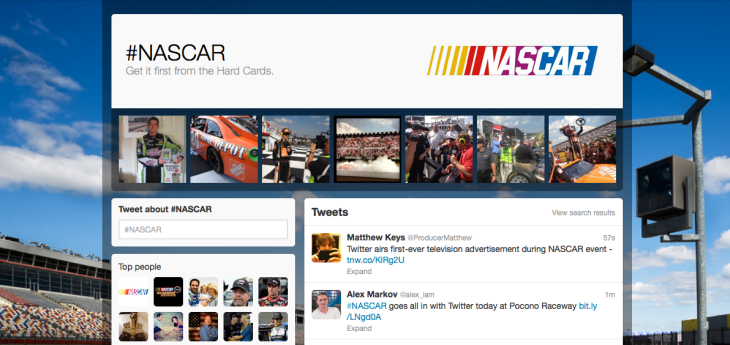Twitter launched its first TV ad Sunday, and it was all about NASCAR. But beyond just getting the attention of NASCAR Twitter followers, the ad is also meant to show off what brands can get if they partner with the social network. Based on what we’ve heard, we’re pretty sure the ad Twitter ran on TNT during the Pocono 400 is all about calling attention to a revamped page displaying search results for a topical keyword — a hashtag, in Twitter parlance.
Business Insider was first to notice that Twitter.com/#NASCAR redirects to twitter.com/hashtag/nascar, a new landing page for the race league. On its blog Thursday, Twitter gave a preview of what NASCAR fans could expect if they tuned into the Twitter.com/#NASCAR page. That includes commentary from drivers, their crews, and expert commentators, as well as a whole bunch of beautiful behind-the-scenes photos, all surfaced through a combination of algorithms and curation by the race league. It’s a way for Twitter and NASCAR to help fans sift through all the noise that they’d find if they just looked at the #NASCAR hashtag in search.
The bigger picture here, though, is that this is the first instance of Twitter launching a brand page based on its hashtag. And the NASCAR campaign, as well as the TV spot, aren’t just aimed at race fans — they’re also a pitch to a whole bunch of other brand marketers as a way to show off what Twitter’s hashtag pages are capable of.
It’s safe to assume that there will be more partnerships like this in the future. NASCAR won’t be the last sports league or big brand to take advantage of a Twitter hashtag page. Based on the success of this weekend’s experiment, we expect more brands to jump on board and curate social marketing pages based on their own hashtags. Rather than simply purchasing sponsored hashtags or tweets, they’ll now be able to curate the experience around what people are saying.
The launch of hashtag pages will also serve to add another channel for social marketers, and could confuse users in an already crowded and fragmented market for consumers’ attention. (And to be honest, the whole thing kind of reminds me of AOL keywords, where that was the place to go for all the news and commentary around a brand.) It’s no longer enough just to have a website — increasingly brands have to be everywhere users expect them to be, which means a Facebook page and now, apparently, a Twitter hashtag as well.
